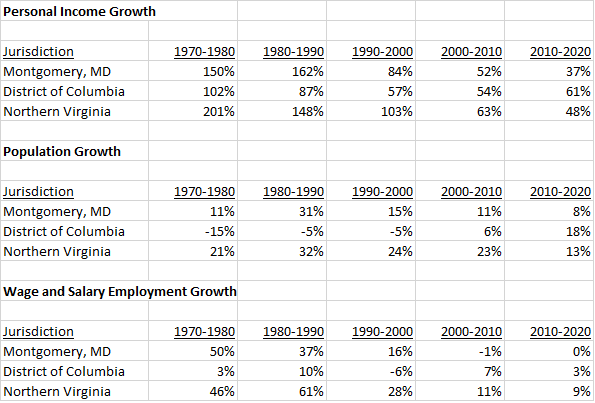By Adam Pagnucco.
Few issues have been more debated by county leaders and activists over the past three years than Thrive 2050, the long-term growth plan just passed by the county council. Thrive’s supporters depict it as a path to a housing-abundant utopia. Thrive’s opponents depict it as a giveaway to developers that would destroy the county’s neighborhoods. Who is right?
Part of me wants to say: who cares?
Look, the county’s housing shortage is real. Home prices and rents are both rising and are testing the limits of affordability. The rest of the region has similar pressures. Thrive is an honest effort to address the need for new housing whether one agrees with its details or not.
But let’s understand what Thrive is: it’s a plan, a piece of paper (or a pdf in the cloud) that does not erect a single solitary housing unit. The county has lots of plans. We are actually very good at planning and we have close to 200 staffers in the planning department who do it. Look at our huge list of master plans, which are continually updated. We plan our county more rigorously than Eisenhower planned D-Day.
I am not dismissing the value of these plans. When I first moved to the county in 2003, I read the master plan for my neighborhood (Forest Glen) that was then in effect. It was a marvelous document and I learned TONS about my new neighborhood – its housing, its transportation network, its environment and a whole lot more. It has since been superseded by a new plan. And here is a curious thing – many things recommended in the old plan were not built by the time the new plan was passed 24 years later. They include “an attractive, landscaped boulevard along Georgia Avenue,” new housing on top of the Forest Glen Metro station, dedicated left-turn lanes at Georgia and Forest Glen Road, a traffic signal at Georgia and Belvedere Boulevard, additional sidewalks on Forest Glen and Belvedere and lots more. There was a whole lot of planning and not a whole lot of building.
And that’s the reality for many of our plans – they call for things that are never built. If there is any master plan in the county that is ever fully built-out before it is replaced by a new master plan, that would surprise me. The unbuilt things apply to both private investments (like new commercial and residential buildings) and public investments (especially transportation infrastructure). If you are unhappy with development plans proposed by the county for your neighborhood, you may not have much to worry about since they may never be built.
That reveals a central truth – Montgomery County does not have a planning problem. It has an investment problem.
Why do I say that? The county’s plans may provide a framework for development, but that development will only be built if the private sector wants it to be built. For that to happen, the private sector and its huge network of financiers, developers, contractors, business owners, tenants and homeowners has to perceive our community as a great place to create jobs, move in, start families and build stuff. If they do that, our economy will grow, our tax base will grow and we will be able to afford the infrastructure to support that growth. If not, the county’s plans are little more than shards of dead trees (or meaningless pixels in cyberspace).
Much has been written about the state of our economy, especially by former county council and planning analyst Jacob Sesker on his great blog, MoCo Economy Watch. But I am going to keep things simple with three data series over the last 50 years: personal income, population and wage and salary employment, all from the U.S. Bureau of Economic Analysis. The table below shows how MoCo compares on those measures with D.C. and Northern Virginia over the decades. For purposes of this presentation, Northern Virginia includes Arlington, Fairfax, Loudoun and Prince William counties plus the independent cities of Alexandria, Fairfax, Falls Church, Manassas and Manassas Park.

Personal income growth: MoCo was competitive on this measure with D.C. and Virginia for many years, but by the most recent decade, we were lagging both of them.
Population growth: D.C. shrank in the 1970s, 1980s and 1990s but now its population is growing faster than MoCo and Virginia. We have trailed Virginia in population growth since the 1990s and now we are trailing D.C. too.
Wage and salary employment: We once led D.C. and were within striking distance of Virginia in wage and salary employment growth but not anymore. Over the last 20 years, we have had essentially no growth on this measure. D.C. and Virginia are snagging the jobs.
And so we have an investment problem. Businesses prefer to create jobs in D.C. and Virginia more than in Montgomery County and residents are beginning to follow those jobs. This is a serious threat to our economic performance, our tax base and our quality of life. Thrive by itself is not going to fix it. All the planning in the world won’t fix it unless county leaders make it their number one priority to do everything in their power to solve our investment problem. If they do that and these numbers turn around, I’ll get excited. And Thrive? I favor it. But will it really make a difference?
